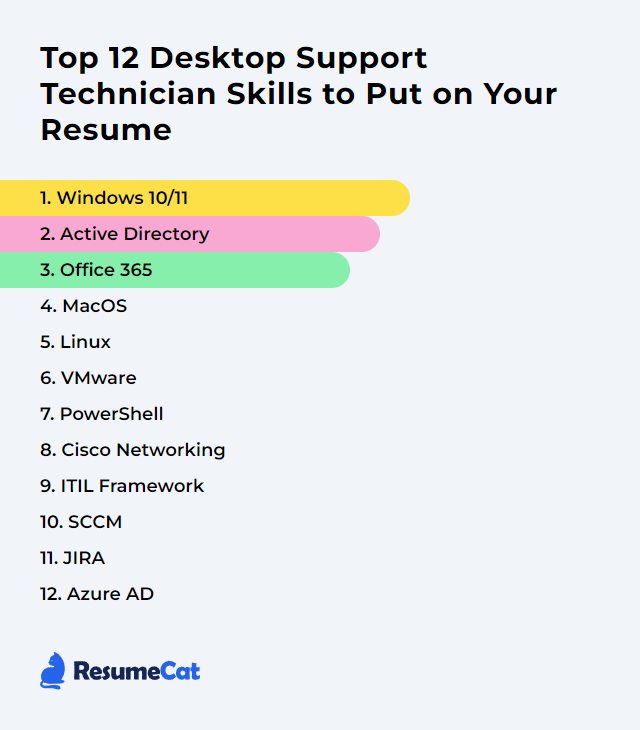Top 12 Desktop Support Technician Skills to Put on Your Resume
In the ever-evolving field of IT, a Desktop Support Technician keeps the lights on and the wheels turning. Systems hum, people work, deadlines don’t combust. A clear, well-rounded skills section on your resume signals you can troubleshoot calmly under fire, collaborate without drama, and keep users productive when the network decides to be moody.
Desktop Support Technician Skills
- Windows 10/11
- Active Directory
- Office 365
- MacOS
- Linux
- VMware
- PowerShell
- Cisco Networking
- ITIL Framework
- SCCM
- JIRA
- Azure AD
1. Windows 10/11
Windows 10 and Windows 11 are Microsoft’s current desktop operating systems for PCs, laptops, and tablets. Familiar territory for business. Graphical interface, deep hardware compatibility, modern security, and constant updates. As a Desktop Support Technician, you install, configure, harden, troubleshoot, and keep them healthy so users can get work done without friction.
Why It's Important
Windows 10/11 dominate the corporate desktop. They ship strong security features, broad app support, and predictable servicing. Knowing them well means faster fixes, fewer calls, and safer endpoints.
How to Improve Windows 10/11 Skills
Sharper systems, calmer users:
- Stay current: Keep OS, drivers, and firmware updated. Stagger rings if you manage fleets.
- Tame startup: Disable nonessential startup apps in Task Manager to cut boot drag.
- Storage hygiene: Use Storage Sense and Disk Cleanup; check SMART health; defrag HDDs (not SSDs).
- Visual effects: Adjust for performance in System Properties when machines feel sluggish.
- Power plans: For desktops, favor balanced or performance profiles; ensure sleep/hibernate policies fit use cases.
- Hardware lift: SSDs over HDDs, more RAM for heavy multitaskers, Wi‑Fi 6 where possible.
- Security baseline: Ensure Microsoft Defender Antivirus is active, updates flow, BitLocker where appropriate, and SmartScreen on.
- Troubleshooters: Use built-in troubleshooters and Reliability Monitor; Event Viewer will tell on misbehaving drivers.
- Proactive care: Schedule updates, scans, and periodic cleanup. Document standard images and drivers.
- User coaching: Quick tips on OneDrive, virtual desktops, clipboard history, and phishing awareness reduce tickets.
Keep tabs on release notes and new policies; the platform moves fast.
How to Display Windows 10/11 Skills on Your Resume
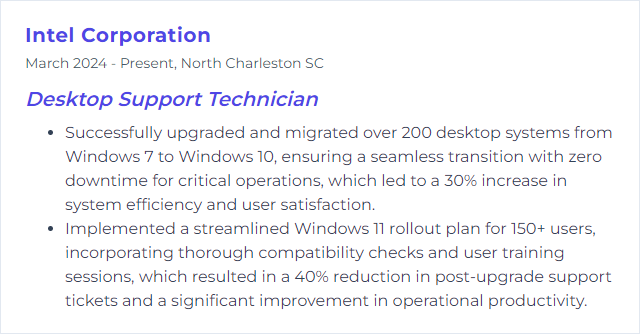
2. Active Directory
Active Directory (AD) is Microsoft’s on-premises directory service for identity, authentication, and authorization. It centralizes users, computers, policies, and permissions. For desktop support, it’s the backbone of account creation, password resets, group membership, printer and share access, and Group Policy enforcement.
Why It's Important
AD keeps user access consistent and secure. Central control slashes chaos: fewer misconfigurations, quicker onboarding, tighter permissioning.
How to Improve Active Directory Skills
- Patch domain controllers: Regularly apply security updates and review supported functional levels.
- Harden identity: Enforce strong password and lockout policies; consider fine-grained policies for privileged groups.
- Design OUs cleanly: Structure by function or geography; keep GPO scope predictable and minimal.
- GPO hygiene: Consolidate redundant policies, use WMI/security filtering carefully, and test in staging.
- Audit and alert: Enable advanced auditing for sign-ins and changes; monitor for anomalies.
- Least privilege: Tier admin accounts, avoid domain admin for daily work, and use privileged workstations for sensitive tasks.
- Backup and recovery: Capture system state, enable AD Recycle Bin, and rehearse forest and object recovery.
- Lifecycle processes: Joiners, movers, leavers—automate where possible; disable before delete.
- Document everything: OU maps, GPO purpose, service accounts, and delegation boundaries.
How to Display Active Directory Skills on Your Resume
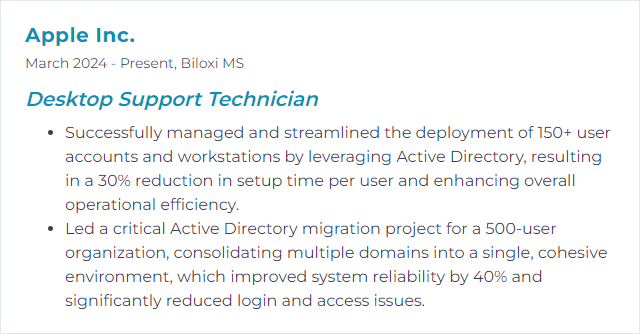
3. Office 365
Office 365—now Microsoft 365—bundles Word, Excel, Outlook, Teams, OneDrive, SharePoint, and more into a cloud-first productivity suite. Anywhere access, collaboration, constant updates. It’s the daily toolkit for most business users.
Why It's Important
When Microsoft 365 sings, users fly. Mail flows, files sync, meetings work, documents co-author. Desktop support becomes smoother, not louder.
How to Improve Office 365 Skills
- Network sanity: Ensure reliable DNS, low-latency paths to Microsoft 365 endpoints, and sensible proxy exceptions.
- Support tools: Use the Microsoft Support and Recovery Assistant for rapid diagnosis of Outlook and Teams hiccups.
- Outlook tuning: Right-size cached mode, trim add-ins, and rebuild profiles only when evidence points there.
- Update channels: Pick the right update cadence; pilot first, then broad deployment.
- Service health: Watch the admin center for advisories; communicate outages before the rumor mill spins.
- Security posture: Enforce MFA, Safe Links/Safe Attachments where licensed, DLP for sensitive data, and baseline policies.
- OneDrive basics: Enable Known Folder Move, teach sync conflict recovery, and confirm storage quotas.
- Enablement: Short training hits on Teams etiquette, file sharing, and meeting setups pay off quickly.
How to Display Office 365 Skills on Your Resume
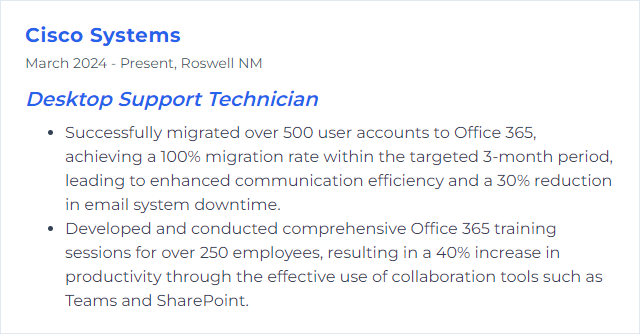
4. MacOS
macOS powers Apple’s Macs with a polished GUI, strong security model, and deep ties to Apple’s ecosystem. Different knobs than Windows, same endgame: keep users productive.
Why It's Important
Plenty of teams run mixed environments. Knowing macOS means you resolve issues fast—without forcing workarounds that break workflows.
How to Improve MacOS Skills
- Update wisely: Keep macOS and apps current; verify critical workflows in pilot machines first.
- Storage housekeeping: Use built-in storage optimization; archive or delete large unused files; empty purgeable space.
- Right-size hardware: Add RAM on upgradable Intel Macs; prefer SSDs always.
- Startup control: Trim login items and launch agents to quicken boot and reduce background churn.
- Reset where it helps: SMC and NVRAM resets (Intel) can clear power, thermal, and display quirks; understand Apple silicon differences.
- Activity Monitor: Hunt runaway processes, memory pressure, and I/O spikes; act before fans scream.
- Disk Utility: Run First Aid for file system concerns; don’t ignore early warning signs.
- Backups: Time Machine or image-based backups before major changes or OS upgrades.
- Keep it lean: Avoid aggressive “cleaner” apps; rely on native tools and targeted maintenance.
How to Display MacOS Skills on Your Resume
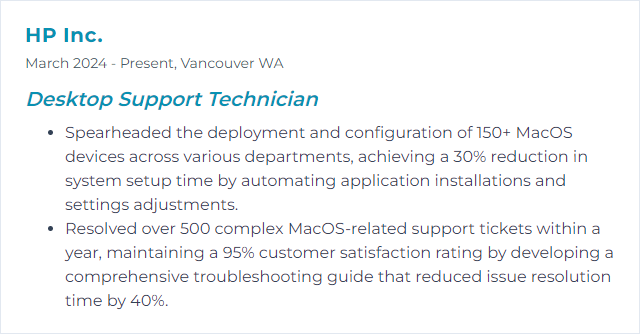
5. Linux
Linux is a Unix-like, open-source kernel that powers countless distributions. It’s prized for stability, security, and flexibility—from desktops to servers to embedded devices.
Why It's Important
Even in Windows-heavy shops, Linux appears—WSL, servers, dev machines, appliances. Comfort at the terminal turns mysteries into manageable tasks.
How to Improve Linux Skills
- Stay updated: Patch the OS and apps regularly with your distro’s package manager.
sudo apt update && sudo apt upgrade- Trusted repos: Stick to official and reputable repositories to avoid surprise breakage.
- Faster boots: Limit startup services; mask what you don’t need; review systemd units.
- Watch resources: Use htop, free, iotop, and journalctl to spot hotspots and errors.
- Security basics: Enable a firewall (ufw/firewalld), keep SSH sane, and prune unused services.
- Pick the right desktop: Lightweight options like XFCE or LXDE keep older hardware useful.
- Back up: File-level and image-level backups; test restore paths, not just backups.
- Storage speed: SSDs plus periodic TRIM; check fstab options and I/O schedulers.
- Command-line fluency: Learn pipes, grep/awk/sed, package tooling, systemctl, and permissions.
- Community wisdom: Read release notes and distro wikis; document fixes you discover.
How to Display Linux Skills on Your Resume

6. VMware
VMware provides virtualization platforms that let multiple operating systems run on one physical host. For desktop support, that means safe testing, isolated troubleshooting, and efficient labs. In enterprises, it often underpins virtual desktops and servers.
Why It's Important
Virtual machines reduce risk. You can reproduce issues, snapshot before changes, and roll back when experiments go sideways.
How to Improve VMware Skills
- Tune VM resources: Allocate CPU, memory, and disk thoughtfully; avoid overcommitting into swap storms.
- Keep VMware Tools current: Better drivers, time sync, and graphics stability.
- Use paravirtual devices: VMXNET3 for networking and PVSCSI for storage to cut CPU overhead.
- Mind storage: Monitor latency; leverage Storage I/O Control where available; avoid thin-provision creep.
- Patch hosts and guests: Security and performance rely on timely updates.
- Snapshot discipline: Short-lived for testing only; consolidate and delete after use.
- Observe: Check performance charts and logs; fix bottlenecks before users feel them.
- VDI nuances: For Horizon deployments, optimize golden images, profile management, and display protocols.
How to Display VMware Skills on Your Resume
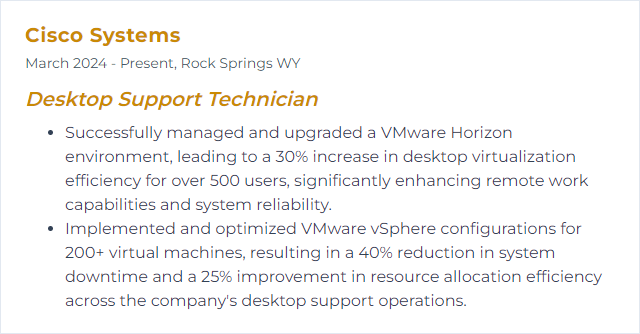
7. PowerShell
PowerShell is Microsoft’s automation and configuration shell and scripting language, now cross-platform (Windows, macOS, Linux) with PowerShell 7+. It’s built for administrators who want repeatable, reliable workflows.
Why It's Important
Manual clicks don’t scale. PowerShell turns repetitive chores into fast, testable scripts—and enforces consistency across fleets.
How to Improve PowerShell Skills
- Core fluency: Master pipelines, objects, common cmdlets, and the help system (Get-Help, Get-Command).
- Modules that matter: Learn ActiveDirectory, NetAdapter, PSWindowsUpdate, and Microsoft Graph modules relevant to your environment.
- Error-savvy scripts: Use Try/Catch/Finally, $ErrorActionPreference, and structured logging.
- Remoting: Configure WinRM or SSH remoting; run commands across many machines safely.
- Automation glue: Scheduled tasks, Azure Automation/desired state tools where available, parameterized scripts.
- Secure habits: Sign scripts, avoid storing secrets in plain text, and respect Just Enough Administration (JEA).
- Version control: Track scripts with Git; review changes; keep a repo of tested snippets.
How to Display PowerShell Skills on Your Resume

8. Cisco Networking
Cisco networking covers switches, routers, wireless, and security gear that move packets from A to B without tantrums. For desktop support, that translates into stable connectivity, accurate VLAN placement, and swift troubleshooting when links get temperamental.
Why It's Important
No network, no work. Understanding the basics keeps tickets from snowballing—IP addressing, routing, switching, Wi‑Fi, and how they intertwine.
How to Improve Cisco Networking Skills
- Master fundamentals: Subnetting, VLANs, STP, routing protocols, DHCP, DNS—the toolkit under every outage.
- Hands-on practice: Configure labs with simulators or spare gear; break things, then fix them.
- CLI confidence: Get comfortable with show, debug (carefully), and config modes; document changes religiously.
- Wireless awareness: Survey signal, channel planning, power levels, and roaming behavior.
- Observability: Use syslog and SNMP, review interface counters, and tracepath issues end to end.
- Cert path (optional): CCNA-level knowledge builds a sturdy base.
How to Display Cisco Networking Skills on Your Resume

9. ITIL Framework
ITIL is a library of best practices for IT service management. The current iteration, ITIL 4, focuses on value, processes, and continual improvement. For desktop support, it structures the chaos: incidents, requests, problems, changes—handled consistently.
Why It's Important
Process reduces noise. Clear workflows, defined SLAs, and good handoffs shrink resolution time and raise satisfaction.
How to Improve ITIL Framework Skills
- User-first thinking: Gather feedback, map journeys, and fix the pain points users actually feel.
- Lean and agile: Trim waste, iterate fast, and adapt processes as reality shifts.
- Automate the repeatable: Ticket routing, notifications, approvals—reduce the manual drudgery.
- Knowledge matters: Build concise, searchable KB articles; push “shift-left” by empowering users and Tier 1.
- Collaboration: Keep ops, security, and networking in the loop; standardize handoffs and escalation paths.
- Measure and improve: Track MTTR, first-contact resolution, backlog aging; review trends and fix root causes.
How to Display ITIL Framework Skills on Your Resume
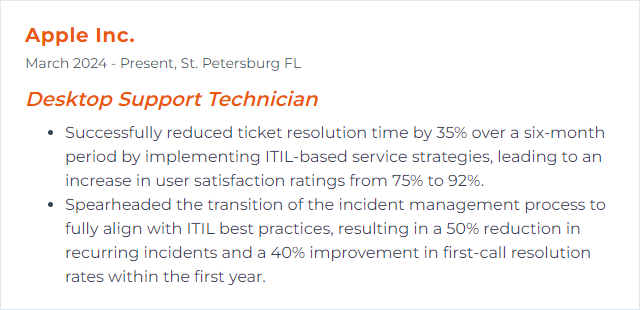
10. SCCM
SCCM (System Center Configuration Manager)—now Microsoft Configuration Manager as part of the Microsoft Intune family—manages Windows devices at scale: OS deployment, apps, updates, compliance, inventory, and more.
Why It's Important
Centralized control means predictable endpoints. Less drift, faster patching, and fewer one-off fixes.
How to Improve SCCM Skills
- Application Model: Use detection rules, dependencies, and supersedence for tidy deployments.
- Inventory clarity: Leverage hardware/software inventory and asset intelligence; trust data, not guesses.
- Patch automation: Configure Automatic Deployment Rules thoughtfully; pilot rings before broad release.
- Endpoint protection: Integrate with Microsoft Defender; align policies and monitor compliance.
- Task Sequences: Streamline OS deployments; update drivers and packages, minimize reboots, add validation steps.
- PowerShell: Script routine actions and reporting; reduce click-heavy work.
- Co-management: Where possible, connect with Intune for modern management features and flexibility.
- CMPivot and queries: Ask live questions of your fleet and act quickly on findings.
How to Display SCCM Skills on Your Resume

11. JIRA
Jira is Atlassian’s platform for tracking work—projects, issues, and service requests. For desktop support, it’s the heartbeat of ticket intake, prioritization, communication, and closure.
Why It's Important
Clarity and visibility. Everyone sees status, ownership, and next steps. Fewer “any update?” pings.
How to Improve JIRA Skills
- Focused dashboards: Surface what matters—unassigned, breached SLAs, pending approvals, escalations.
- Automation rules: Auto-assign by component, set priorities, send updates, transition states on triggers.
- Knowledge integration: Link tickets to relevant KB articles; close the loop with documented fixes.
- Service portals: Use clear request types and forms; reduce back-and-forth by capturing the right details up front.
- Feedback loops: Gather user satisfaction and technician suggestions; turn patterns into improvements.
- Consistent workflows: Keep states simple, transitions clear, and SLAs realistic.
How to Display JIRA Skills on Your Resume
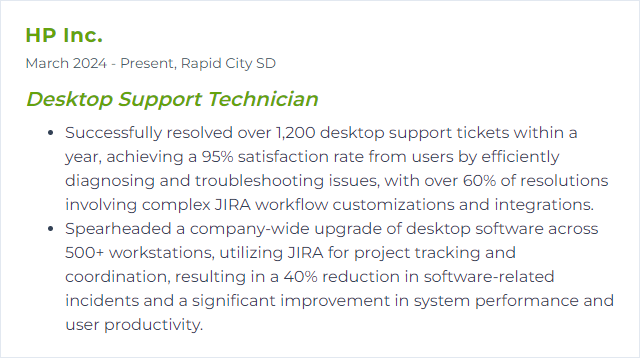
12. Azure AD
Azure AD—now called Microsoft Entra ID—is Microsoft’s cloud identity and access service. It handles sign-in, SSO, conditional access, and identity governance across cloud and hybrid environments.
Why It's Important
Identity is the new perimeter. Solid configuration here means safer access to apps and data from anywhere, on any device.
How to Improve Azure AD Skills
- Learn the core: Tenants, objects, roles, groups (including dynamic), and app registrations.
- MFA everywhere: Require multi-factor for all users; add phishing-resistant methods where available.
- Conditional Access: Gate access by risk, device compliance, location, and app sensitivity.
- Review regularly: Run access reviews and entitlement checks; prune stale accounts and guest access.
- Protect privileges: Use Privileged Identity Management with time-bound elevation and approvals.
- Identity Protection: Monitor risky sign-ins and users; auto-remediate when appropriate.
- Hybrid hygiene: Keep sync agents current, scope sync appropriately, and monitor health.
- Audit and reports: Watch sign-in logs and audit trails; set alerts for unusual activity.
- User awareness: Train on phishing, device hygiene, and self-service password reset.
How to Display Azure AD Skills on Your Resume

